Home
A comprehensive resource for safe and responsible laser use
Canada: 236 reported laser strikes in 2020
In Canada, a person who intentionally interferes with an aircraft by using a laser faces a prison sentences of up to five years, and a fine of up to $100,000.
From CBC News. Additional examples of 2020 Canadian laser illuminations are in the story.
Canada: Pilots want lasing aircraft to be a crime
Tim Perry made his proposals May 11 2020 after a Jazz Aviation pilot was hospitalized due to being illuminated by laser light on approach to Ottawa/Macdonald-Cartier International Airport, on February 15 2020. The laser source was about three nautical miles from the aircraft. The co-pilot of the de Havilland DHC-8-300 passenger aircraft had to turn control over to the captain, who was able to land without incident. The co-pilot was taken to hospital as a precaution due to actual or potential injuries. No additional information was made available by Jazz due to privacy restrictions.
Perry said that other Canadian aviators have actually suffered permanent retinal damage as a result of laser strikes, according to the National Post. Details on the Jazz pilot's condition, or on the other pilots — how many, degree of severity, eventual outcome — were not listed in the Post article. There were eye injury claims in February 2020 when an Ornge medical support aircraft was struck by a green laser in downtown Toronto, and an eye injury claim by a WestJet pilot flying from Newfoundland to Orlando in May 2019.
The article stated that "Most of the reports in the CADORS [aviation incident] database indicate that police were notified, but neither Transport Canada nor the RCMP [Royal Canadian Mounted Police] could cite an example of anyone in Canada ever being prosecuted." [Note: LaserPointerSafety.com has found at least four cases of Canadian prosecutions.]
Canada has previously taken steps to reduce laser/aircraft incidents. These may be having some effect, as laser incidents have been dropping from a reported high of 658 in 2015, to 274 in 2019, according to the National Post article.
On June 28 2018 Transport Minister Marc Garneau banned the use of hand-held lasers 1 milliwatt or more (the power of a small pet laser pointer) in Toronto, Montreal and Vancouver, and within 10 km of airports or heliports. There are exceptions for uses such as work, education, school or astronomy.
Any person with a battery-operated, handheld laser in a prohibited zone 1) outside of a private dwelling and 2) without a legitimate purpose can be fined immediately and “on the spot” up to CDN $5,000. A corporation violating the law can be fined up to CDN $25,000. The fines are in addition to any criminal prosecution; intentionally aiming a laser at an aircraft can result in five years in prison and/or up to CDN $100,000 in fines.
On May 24 2016, Garneau announced a social media awareness campaign. This included setting up a webpage in June 2015 that includes a catchy animated video, “Dumb Ways to Blind” aimed at millennials, plus three other more conventional videos on the topic. Transport Canada also tweeted using the hashtag "#NotABrightIdea".
Section 7.41(1) of Part I of the Canadian Aeronautics Act is a general prohibition against behavior that endangers aircraft. It provides a fine of up to CDN $100,000 and up to five years in prison for interfering with the duties of a crew member. This has been cited by Transport Canada as part of its webpages discouraging persons from aiming at aircraft.
From the National Post, March 11 2020. Note that there has been a discrepancy between newspaper reports of the number of annual laser/aircraft incidents, and Transport Canada figures. For more information, see the Canada section on the Laser/aircraft illumination statistics page. Thanks to Randy Paura for bringing this news to our attention.
Canada: Restrictions on high-powered handheld lasers in three cities
Persons are banned from possessing such lasers outside of their home, without a legitimate purpose such as work, school, education or astronomy.
Police can question anyone with a laser in one of the prohibited zones if they had a reasonable reason to search them. Examples given included if a member of the public contacted police with a specific description of a person they saw holding a laser, or if police themselves saw the person holding a laser.
Any person with a battery-operated, handheld laser in a prohibited zone 1) outside of a private dwelling and 2) without a legitimate purpose could be fined immediately and “on the spot” up to CDN $5,000. A corporation violating the law would be fined up to CDN $25,000. The fines are in addition to any criminal prosecution; intentionally aiming a laser at an aircraft could result in five years in prison and/or up to CDN $100,000 in fines.
According to Transport Canada, “You don’t need to carry any documentation, but you should be prepared to demonstrate to the officer why you’re in possession of a hand-held laser. Law enforcement will be trained to know when and where people may possess a laser. They will exercise their discretion and judgement when determining whether or not to issue a fine.”
Transport Canada has a webpage with details of the laser prohibitions, a question-and-answer page about the new laser safety measure, and an online forum “Let’s Talk - Lasers” seeking feedback on laser safety issues. The “Let’s Talk - Lasers” consultation closes for comments on August 27 2018.
They also have an online interactive map detailing the prohibited zones. Here are two examples of map output:
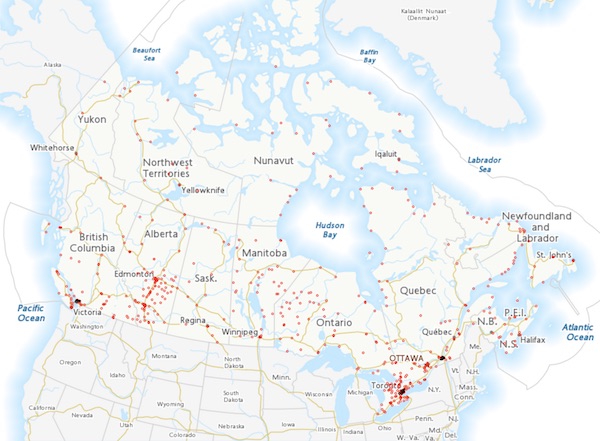
Laser-prohibited zones in the entire country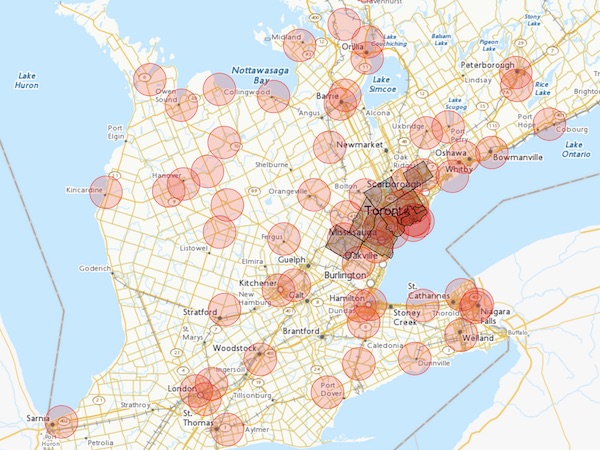
Closeup of laser-prohibited zones in the Toronto area
The three metro areas of Montréal, Toronto and Vancouver were included since, according to Transport Canada, “The majority of reported laser attacks have occurred in these regions. Transport Canada will continue to monitor the number and location of reported incidents and may adjust the included municipalities as warranted.”
The agency discussed how the fines were determined, and how law enforcement will decide on the exact fine amount: “These fines, called administrative monetary penalties, come from the Aeronautics Act and the Canadian Aviation Regulations. Law enforcement uses discretion on how much to fine an individual. The amount may depend on previous infractions and circumstances surrounding this infraction.”
When concluding his announcement, Garneau stated “we have the tools that law enforcement agencies need, including Transport Canada inspectors and police forces, in order to put an end to these careless and reckless actions — actions that could have tragic results.”
From the Canadian Press, the CBC, iPolitics, a video of Marc Garneau’s announcement on GlobalNews.ca, and the Transport Canada informational webpage and Q&A webpage.
For much more information and commentary from LaserPointerSafety.com:
Canada: Looking at "all possible options" to fight laser incidents; perhaps a ban and mandatory labels
The statement came after six laser incidents over two days earlier in the month, at Montreal’s Trudeau Airport. Garneau said these made him “very, very mad.”
A Transport official said the options include a ban on importation of powerful lasers, mandatory warning labels, and stronger penalties for those who are caught.
Garneau noted that it is hard to catch a laser perpetrator, making prosecutions “few and far between”. He believes that some people are not aware of the bright-light danger of laser light, but that others “know darn well what they’re doing” and are trying to “provoke something.”
Transport Canada currently has a program called “Not-a-Bright-Idea,” trying to educate the general public about the risks and legal consequences of aiming lasers at aircraft. Since implementing the program in May 2016, laser incident numbers have dropped. There were 590 reported incidents in 2015, 527 in 2016, and 379 in 2017.
Garneau said that despite the 28 percent drop, Transport Canada must do more, and that is why they are exploring other options.
From 660 News and AVweb
Note: In response to a LaserPointerSafety.com request, an email address for interested persons was provided: “Transport Canada is exploring options to reduce laser strikes. Canadians and industry members can provide information to the Civil Aviation Communications Centre by emailing: services@tc.gc.ca”
Canada: Transport Canada warning of laser dangers via social media
The campaign began with a press conference where Marc Garneau, Minister of Transport and Tony Cusimano, Superintendent of York Regional Police spoke about the hazards.
Garneau said, "Pointing a laser at an aircraft is not only a reckless act that puts people at unnecessary risk, it’s simply not a bright idea. As Minister of Transport, I take this type of behaviour seriously because Canadians and their families deserve to feel safe while flying. We want people to know there are serious consequences, including $100,000 in fines and up to five years in prison. Transport Canada and law enforcement across the country are working together to ensure offenders face the fullest force of the law.”
Transport Canada has set up a website at www.tc.gc.ca/NotABrightIdea. It includes a catchy animated video, “Dumb Ways to Blind” aimed at millennials, plus three other more conventional videos on the topic.
According to the website, “[i]n 2015, there were almost 600 reported incidents.” This was an increase over the 502 incidents reported in 2014.
Transport Canada urges those interested to use the hashtag #NotABrightIdea. On Twitter, since January 1 2016 there have been about 40 posts with this hashtag; 33 of them about lasers and 7 about other topics that are “not a bright idea.”
From a news release issued by Transport Canada
Canada: 663 laser/aircraft incidents in 2015 based on newspaper analysis of CADORS data
Here is the CADORS data:
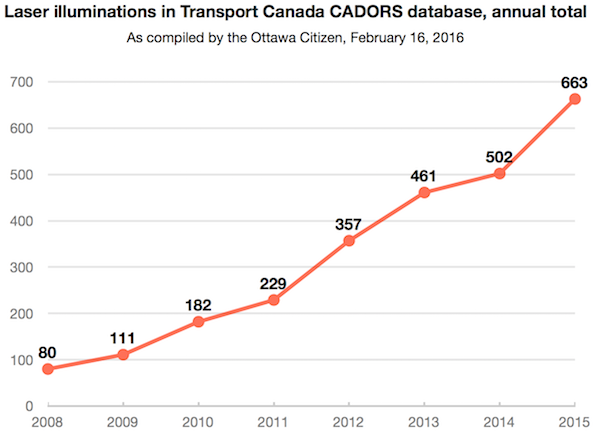
Compare this with the number of illuminations in the United States over the same period:
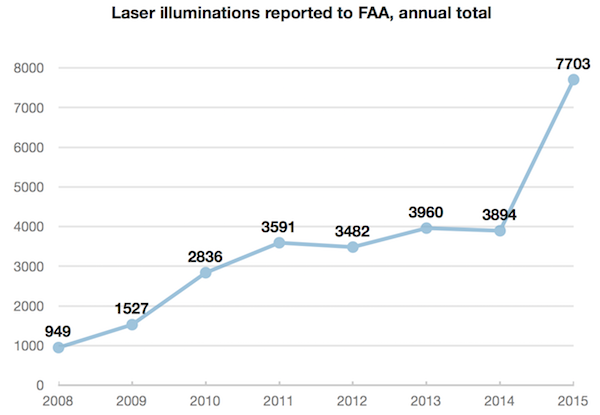
Canada’s data roughly tracks the U.S. data. Here are the two charts above, superimposed, with the CADORS numbers multiplied 11.7 times. The slope of the lines are similar for all but 2013/2014, and the endpoints are remarkably close.
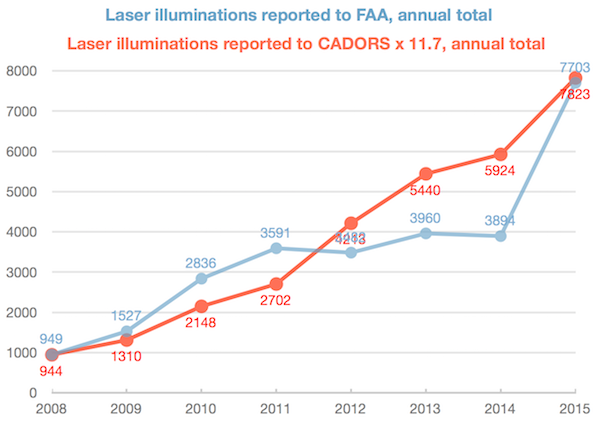
From an analysis by Andrew Duffy in the Ottawa Citizen. Note that a few days earlier, CBC News stated that there were 590 laser/aircraft incidents in 2015. There is no indication as to reasons for the discrepancy.
Canada: 590 laser/aircraft incidents in 2015; pilot group wants handheld lasers classed as weapons
The head of the Air Canada Pilots Association said that the figures show that education is not working, and handheld lasers should be designated as prohibited weapons.
From CBC News. Note that a few days later, the Ottawa Citizen did an analysis of Transport Canada’s database which shows different figures: 663 laser incidents in 2015, which is up 32% from the 2014 total of 502.
Canada: Government launches safety campaign to warn against pointing lasers at aircraft
Helping Canadians better understand the dangers lasers pose to aircraft
The Honourable Alice Wong, Minister of State (Seniors), on behalf of the Honourable Lisa Raitt, Minister of Transport, today launched the Government of Canada’s safety awareness campaign for lasers. The national campaign will help Canadians better understand why pointing a laser at aircraft is not a bright idea.
The first phase of the campaign, unveiled today in collaboration with the Vancouver International Airport, the RCMP, and NAV CANADA, provides the public with an easy to follow infographic, which clarifies the dangers and consequences of pointing lasers into airspace and how incidents can be reported. This summer, the second phase of the campaign will include digital advertising, awareness videos and a direct mail campaign near three major airports.
Transport Canada has also launched tc.gc.ca/NotABrightIdea, which provides Canadians with the information they need to better understand the dangers of pointing a laser at an aircraft.
Transport Canada is working closely with police, other government departments, and the aviation industry to protect pilots, passengers, and people on the ground. If you see a laser pointed at an aircraft, report it to your local police.
Quick Facts
- The number of lasers pointed at aircraft is rising in Canada. In 2014, there were 502 reported incidents – a 43% increase since 2012.
- Aiming a laser at an aircraft is a federal offence. If convicted under the Aeronautics Act, an offender could face up to $100,000 in fines, 5 years in prison, or both.
- Canadians can join the conversation and learn more by using the #NotABrightIdea hashtag on Twitter.
Canada: 502 laser/aircraft incidents in 2014
From the Transport Canada webpage Aiming a laser at an aircraft? Not a Bright Idea.
Canada: Laser statistics for 2010, 2011 and Q1 2012
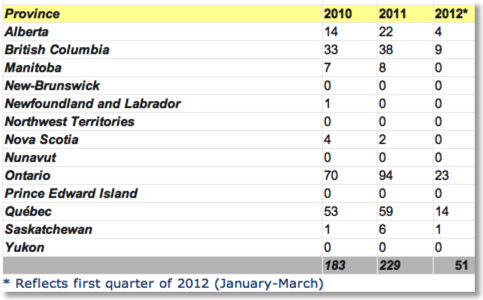
According to the Toronto Star, from January 1 to late May 2012 there have been 36 laser incidents at Pearson International and other Toronto-area airports, and 100 incidents nationwide. (This is probably based on their own analysis of the CADORS incident database since the Transport Canada chart above only went through the first quarter of 2012.)
WestJet has arranged for a Calgary-based ophthalmologist to examine pilots’ eyes after laser incidents. A spokesperson said “We want to have an individual identified in every major city so we can send that (pilot) right away to be tested.”
Canada lags other countries in aggressively prosecuting offenders, according to the chair of the flight safety division of the Air Canada Pilots Association: “The judicial system should apply the law to its maximum extent rather than soft-shoeing around the issue.” At the federal level, aiming a “directed bright light” at an aircraft is illegal under the Aeronautics Act. The maximum penalties are a prison term of five years and a fine of $100,000.
From the Toronto Star; chart courtesy Transport Canada
UPDATE, May 30 2012: At LaserPointerSafety.com’s request, Transport Canada analyzed first quarter incident statistics for the past three years. They found 29 incidents in Q1 2010, 27 incidents in Q1 2011, and 53 incidents in Q1 2012. (Note that they found two additional Q1 2012 incidents which were not included in the province-by-province breakdown above.) A Transport Canada spokesperson speculated that reasons for increased incidents in general may include increased awareness and reporting by pilots, and “copycat” actions by persons who would not think to aim a laser at aircraft until they hear news reports of incidents.
Canada: 2010 laser/aircraft incidents almost double 2009
Transport Canada also released figures on incidents in Alberta, after an Aug. 16 arrest in Calgary. So far in 2010, there have been 11 reports of laser beams aimed at or hitting aircraft, compared with nine in all of 2009.
From the Calgary Herald
Canada: List of many Canadian incidents
- A Cessna pilot flying over downtown Vancouver on May 25 2009, who had "flash blindness for a few seconds"
- More than two dozen reports of lasers being directed at airplanes in British Columbia since 2000.
- About 100 incidents of laser beams pointed at aircraft across Canada, since 2005.
- A Cessna pilot in June 2008 who "experienced slight vision impairment, and for safety reasons requested a wide left-hand 270-degree turn ... for brightness recovery and a stabilized approach".
- A helicopter co-pilot in November 2007 who looked at a laser and "was experiencing sun spots [sic] in her vision, which continued for the remainder of the flight."
- At least three incidents, two in June and one in November 2008, where Royal Canadian Mounted Police pilots were targeted.
- In July 2008, a Calgary man was fined $1000 after pleading guilty to shining a laser at an Air Canada flight.
Culbert's story also lists the first attack LaserPointerSafety.com is aware of on a blimp: "A green light was pointed into the cockpit of a blimp over Victoria's [B.C.] shoreline in October 2005. [CADORS reported that] 'several laser attempts were made and the pilot said he was affected twice. Quite aggressive attempts were made by the person using the laser light according to the pilot.' "
Canada: Pilots call for better labeling; tougher penalties
According to Transport Canada, there have already been 56 occurrences this year [2008] compared with 21 in 2007. The department has recorded a total of 83 since 2005.
"The increase in the number of laser events that are occurring in Canada and around the world are alarming to us," said Capt. Barry Wiszniowski of the Air Canada Pilots Association. "The laser events that are occurring are probably one of the greatest safety concerns that we have right now as a profession."
Wiszniowski said the industry is calling on laser manufacturers to develop labeling that will contain warnings similar to those on tobacco products.
He is also encouraging the courts to issue stiffer penalties to offenders.
Many more details at Metronews
Canada: Number of pilots blinded by laser pointers increases
As of October 17 this year, Transport Canada had received 46 reports of incidents involving "directed bright lights" being shone at a civilian airplane's cockpit from the ground, says Jean Riverin, a spokesman for the national regulator. This compares with 21 reports for all of 2007, and only three each for 2006 and 2005. When Transport Canada receives a complaint, adds Riverin, "we notify the RCMP or local police, who coordinates the investigation."
It is an offense under section 74.1 of the federal Aeronautics Act to "engage in any behaviour that endangers the safety or security of an aircraft in flight." A violation of the act can lead to a maximum penalty of $100,000 or five years imprisonment following a conviction, or to $25,000 or 18 months imprisonment following a summary conviction.
Click to read more...